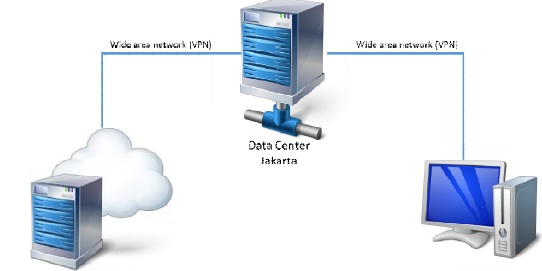Analisis Performansi Dan Efisiensi Cloud Computing Pada Sistem Perbankan
Abstract
The use of physical server for Bank Mandiri branch office operations has several shortcomings, namely the high server procurement costs, limited part upgrading, maintenance costs, land requirements and electricity consumption. An alternative that can be used is cloud computing technology based on virtualization with the ROCCA adoption method. In this research, cloud computing is implemented to run the operational applications of Bank Mandiri branch offices using Microsoft Hyper-V virtualization. Then the performance and value of cost efficiency are compared to the physical server. Implementation results indicate the ROCCA method can be used for cloud computing adoption in the banking sector. Measurement of physical server performance reaches a score of 36% while the cloud server 9%, physical server memory reaches a score of 35% while the cloud server 50%, and the physical server harddisk reach a score of 48% and cloud server 52%. A higher percentage indicates better performance. Regarding to network speed, the physical server reaches a bandwidth of 94.9 Mbits / sec, while the cloud server 94.1 Mbits / sec. In terms of investment efficiency is not too significant, where in 5 years the efficiency value is 1.8% and for 10 years it is 2.81%.
Downloads
References
[2] A. R. Hakim, “Analisis Perbandingan Sistem Cloud Azure Dan Google Cloud,” J. Nas. Inform. Teknol. Jar., Sep. 2016.
[3] K. Sunami, “Ubiquitous Banks: Cloud Based Design for Core Banking,” Int. J. Adv. Res. Comput. Sci., vol. Volume 8, No. 2, March 2017 (Special Issue), 2017.
[4] A. Aljabre, “Cloud Computing for Increased Business Value,” 2012.
[5] S. Heripracoyo, “Analisa Studi Literatur Manfaat Implementasi Komputasi Awan Untuk Perusahaan,” 2014.
[6] K. Rathod, “Cloud Computing – Key Pillar For Digital India,” Int. J. Inf. Sci. Tech. IJIST, vol. Vol.6, no. No.1/2, 2016.
[7] S. K. Sharma, A. H. Al-Badi, S. M. Govindaluri, and M. H. Al-Kharusi, “Predicting Motivators Of Cloud Computing Adoption: A Developing Country Perspective,” Comput. Hum. Behav., vol. 62, 2016.
[8] P. Rieger, H. Gewald, and B. Schumacher, “Cloud-Computing in Banking Influential Factors, Benefits and Risks from a Decision Makers Perspective.” Researchgate, 2013.
[9] B. Nedelcu, M.-E. Stefanet, I.-F. Tamasescu, S.-E. Tintoiu, and A. Vezeanu, “Cloud Computing and its Challenges and Benefits in the Bank System,” Database Syst. J., vol. VI, no. 1, 2015.
[10] C. Agre, “Implementation of a Cloud in Banking Sector,” 2015.
[11] P. Goel, “Cloud Computing- Banking on the Cloud,” 2013.
[12] A. Irfan and P. I. Santosa, “Adopsi Cloud Computing Pada UKM Di Indonesia,” 2015.
[13] A. Apostu, E. Rednic, and F. Puican, “Modeling Cloud architecture in banking systems,” elsevier, 2012.
[14] S. Goyal, “Public vs Private vs Hybrid vs Community - Cloud Computing: A Critical Review,” IJ Comput. Netw. Inf. Secur., 2014.
[15] V. Chang, R. J. Walters, and G. B. Wills, “Organisational Sustainability Modelling –anemerging service and analytics model for evaluating Cloud Computing adoptionwith two case studies,” Int. J. Inf. Manag., vol. Vol. 36, no. 1, pp. 167–179, 2016.
[16] D. Ray, “Cloud Adoption Decisions: Benefitting from an Integrated Perspective,” TheElectronic J. Inf. Syst. Eval., vol. Vol. 19, no. No.1, 2016.
[17] F. Shimba, “Cloud Computing :Strategies for Cloud Computing Adoption,” 2010.
[18] M. Suprayogi, “Implementasi Cloud Computing Menggunakan Model Adopsi Roadmap For Cloud Computing Adoption (ROCCA) Pada Institusi Pendidikan (Studi Kasus Universitas Semarang),” 2014, 2014.
[19] J. Hwang, S. Zeng, F. y Wu, and T. Wood, “A Component-Based Performance Comparison of Four Hypervisors,” 2013.
[20] R. Kumar and S. Charu, “An Importance of Using Virtualization Technology in Cloud Computing,” Glob. J. Comput. Technol., vol. Vol. 1, no. No. 2, 2015.
[21] H. Fayyad-Kazan, L. Perneel, and M. Timmerman, “Benchmarking the Performance of Microsoft Hyper-V server, VMware ESXi and Xen Hypervisors,” 2013.


This work is licensed under a Creative Commons Attribution-NonCommercial-NoDerivatives 4.0 International License.

This work is licensed under a Creative Commons Attribution 4.0 International License




